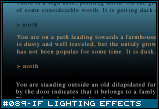|
Mechanic #089 - IF Lighting Effects |
 | Posted: 08/02/08
Play survival horror text adventures where the text is colored to represent world lighting. |
|
Survival Horror Should Be Dark, Right? |
This is a really strange idea that came to me while playing the survival horror game Siren. I started to wonder if maybe the concept of darkness and illumination could be introduced into interactive fiction by coloring the text. I'm not sure it works out, but it's certainly an intriguing premise.
![[light1.png]](set05/img/entry089-light1.png)
The basic concept behind the game is that the text is colored to represent the currently lighting situation. I'm not sure this illustration nails it quite right, but the general premise is the same. When you are outside and it is day, the background will be a white-blue color and the text will be colored such that it is easily readable. During dusk, the background will grow orange and the text yellow (or black) so that it is slightly more difficult to read. At night, the text would be dark and hard to read unless you turned on a flashlight (the text would become yellow).
The same effect would happen indoors. Whatever the ambient light is in the area, the text and background would change to fit. Someplace really bright might have light text on a light background, making it difficult to read (though possible and slightly painful) without finding sunglasses. Darkness would be tough to read without light. Turning the light on in a room would have a more obvious effect than if the description was previously just "It is dark in here. You can't see."
![[light2.png]](set05/img/entry089-light2.png)
Okay, ambient lighting is nifty and all, but where's the neat mechanic? Well, I wanted to emulate something like in Siren where you shine a flashlight - you can only see what you are shining at and the rest of the room is dar, even secret and mysterious. What I came up with is an interactive fiction directional flashlight.
Put simply, there is a small circle on the screen that represents the character and which direction the flashlight is pointed. You can move it around you with the mouse, and as you do, the text description of the room will highlight based on it. For instance, if the flashlight is pointed forward, you might have it pointed at the couch and rug under it - both of which would be highlighted in yellow, with the descriptive text around them slightly less highlighted. Nearby objects would also have a relative amount of highlighting, so the table with the lamp on it might be pretty dark, but not black.
The trick is that you can only examine and interact with objects that are highlighted by the flashlight. Anything which happens that is not in the visible area is either not printed, or printed black-on-black so that you can't read it until you move the flashlight around. You could have the state of things change when dark, like a door that was closed is now open, or a place which usually describes the location of a floor lamp is now replaced with a zombie which had shambled into the room quietly.
To sum up, the text of the room changes as you are looking at it. The world updates real time. By limiting which parts you can see, you can give the player a text-based tunnel vision, allowing the world to contain a darkness worth being afraid of. None of this "You might be eaten by a Grue" crap. |